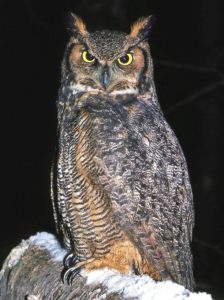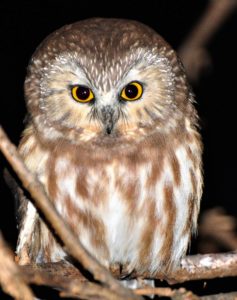Photography courtesy of Lowell Washburn, all rights reserved.
Searching the forest for unsuspecting prey, owls prowl the darkness on silent wings. Although rarely seen in daylight, owls are a lot more common than most folks realize. No matter where you live in Iowa, there are probably owls nearby. They inhabit our state forests and river corridors, live in our farmstead windbreaks, reside in urban backyards.
Since owls are most active at night, catching a glimpse of one presents a challenge. For most of us, the easiest and best way to locate and identify the birds is by using our ears. There are at least nine species of owls that live in or visit Iowa. Each has its own unique set of easy to learn calls. Not everyone enjoys the sounds, of course. Some people find the owl’s nighttime vocalizations downright spooky and eerily unnerving. Other listeners place a high value the midnight crooning and are quick to note that the resonate hooting brings a welcome sense of wildness to an otherwise civilized landscape.
I love listening to owls. And because some of my closest neighbors are owls, I get to listen a lot. The late night hootfests began a couple years ago when a pair of great horned owls appropriated a nearby crow’s nest after evicting – or perhaps killing and eating — the original owners. With its cryptic plumage, stately posture, and piercing yellow eyes; there is no question that the great horned is a handsome predator. Standing two feet tall, it is also Iowa’s largest owl. Commonly referred to as Flying Tigers, horned owls are not gentle. Contrary to popular fable, they are not particularly wise. What they really are are savage predators. Although rodents comprise a good share of their diet, great horneds are not the least bit shy about adding cottontails, pheasants, turkeys, crows, striped skunks, or even other large raptors to the daily menu. Although horned owls will sometimes attack humans to protect their nestlings, such attacks are rare. Most negative interactions appear to be cases of mistaken identity. One of the most extreme occurred when a Canadian hiker suffered a broken neck after a horned owl apparently mistook his muskrat cap for a potential meal. Nighttime fox hunters who play distressed cottontail recordings frequently call in hungry owls before seeing any fox. This would probably not be a good time to be wearing your rabbit fur cap.
Horned owls are the first bird to begin nesting in Iowa each year, and females may become buried in several inches of wet February snow as they sit on eggs. Adult pairs defend well defined territories and become increasingly vocal through December. Courtship activities peak during January and the first eggs appear soon after.
Snow covered, moonlit winter woodlands never seem more alive than when being claimed by courting horned owls. Beginning at, or slightly before sunset, the vocalizations may continue until daybreak. Abandoning the species’ familiar five note hoot, courting owls go completely off script. Males go to the greatest extremes, displaying a bizarre repertoire that simply defies description. When heard at close range, the caterwauling will give you goose bumps.
Not all owls, of course, are as large or potentially dangerous as the great horned. The tiny saw whet owl presents our best contrast. Occurring in Iowa as winter visitors, saw whets nest in Canadian pine forests where they rear their young in abandoned cavities created by pileated woodpeckers. Saw whets are one of the few owls to conduct regular migrations, frequently traveling hundreds of miles between summer and winter homes. Standing around six inches tall and only weighing about four ounces, these blue jay-sized predators depend on a limited prey base. While in Iowa, deer mice provide a protein rich mainstay. Once the daily entree is captured, the owl is so amazingly tiny that it can only consume about half of its catch. If the remainder of the meal freezes, the saw whet is compelled to locate another mouse the following night.
Secretive to an extreme, wintering saw whets are rarely seen. But there are some ways for saw whet enthusiasts to narrow the search. While visiting Iowa, the species retains its fondness for evergreens. Saw whets frequently spend their daylight hours nestled tight to the trunks of pines or cedars. To locate roost trees, look for whitewash along trunks and lower branches and simply follow the trail up. Once discovered, these diminutive predators may prove exceptionally tame. Unfamiliar with the sight of humans, they can sometimes be approached to within inches.
For anyone willing to brave the cold, nighttime owl walks are a great form of winter recreation. For people preferring to use safe, well established trails, Pilot Knob State Park near Forest City, Clear Lake’s Clausen’s Cove, or Mason City’s Lime Creek Nature Center offer excellent opportunities for hearing great horned, barred, screech owls and perhaps other, more uncommon species. Attending the nighttime winter concerts is well worth the effort or any loss of sleep.



 Tom Cope
Tom Cope Sue Wilkinson
Sue Wilkinson Susan Judkins Josten
Susan Judkins Josten Rudi Roeslein
Rudi Roeslein Elyssa McFarland
Elyssa McFarland Mark Langgin
Mark Langgin Adam Janke
Adam Janke Joe Henry
Joe Henry Kristin Ashenbrenner
Kristin Ashenbrenner Joe Wilkinson
Joe Wilkinson Dr. Tammy Mildenstein
Dr. Tammy Mildenstein Sean McMahon
Sean McMahon